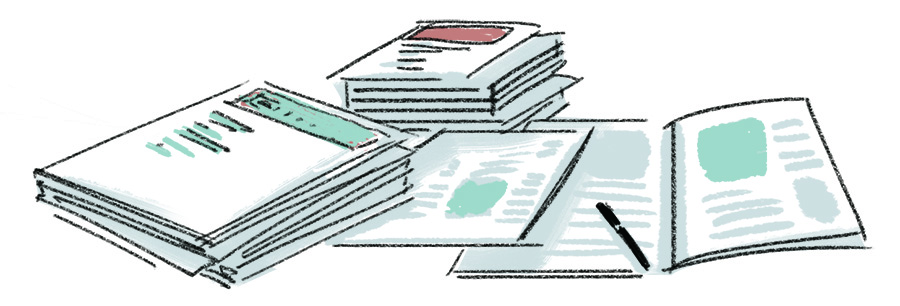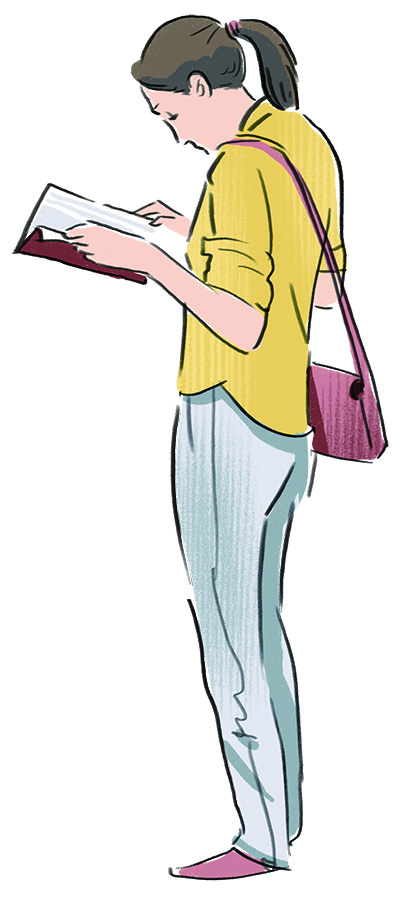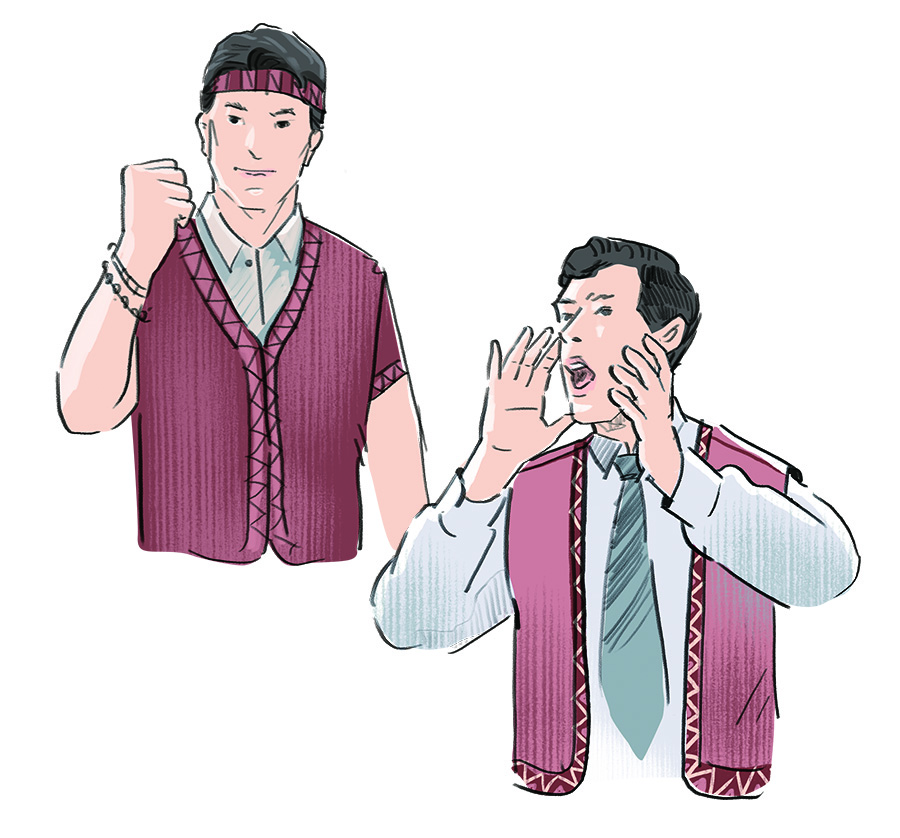At the emergence stage of indigenous movement, the indigenous intellectual took an important step and began their own publications of non-mainstream discourse to influence the mainstream society. Publications still serve as an important medium to convey indigenous ideologies after indigenous movements declined and community culture and thoughts became dominant.
Since 1983 when the first indigenous newsletter, Gao Shan Qing (高山青) was published by the indigenous members, publications play an important role to awaken self-consciousness of indigenous peoples to gain for rights of expression and interpretation freedom and liberate thoughts, to fight against homogenous domination and control of the mainstream media externally. 
Publications and Indigenous Social Movement:
Gao Shan Qing and Singing for Mountains
In 1983, the four National Taiwan University(NTU) students, Iban Nokan, Icyang Parod, Yang Chi-Hang, and Lin Hung-Dung incorporated hand writing and oil printing to publish Gao Shan Qing and in the “Foreword of the Publisher” on the first issue, they declared to reveal discrimination and unfair treatment suffered for the long time by the indigenous peoples with the aim to call for awakening and fighting of indigenous communities. During that time, Taiwan was under martial law, freedoms were suppressed. These indigenous students publically criticized the government and mainstream society and caught the attention of opposition party.
In April, 1984, the “Minorities Commission” (the Commission) was founded by the “Union of Editors and Writers from the Opposition Party” including members such as Kimbo Hu and Tung Chun-Ching. In June of the same year, the Haishan Mining Accident occurred in Tucheng, New Taipei City and among 72 miners killed, 38 were indigenous peoples. Kimbo Hu and others thus organized a fund-raising concert, Singing for Mountains (為山地而歌) and published the magazine with the same name of the concert, the most presentative publication during the Commission period.
Publications of KMT Representatives:
Respectful Mountains and Indigenous Culture
In August, 1984, the KMT indigenous legislator, Wei Hua-Ai found Respectful Mountains (莊敬山脈) Monthly and in February next year, the first issue was officially published. In June of the same year, contents were added to change the publication from newsletter to magazine. The former President of Provincial Legislative , Hua Chia-chi, on April 20th, 1985 republished Indigenous Culture (山地文化) bimonthly five years later after the publication was ceased.
These two publications harshly criticized the Taiwan Indigenous Rights Promotion Association and events it organized with striking titles such as “Work Our Best to Safeguard Pure Indigenous Society and Do not let “the Opposition Party” Pollute Green Mountains” to promote political concepts that try to fool the public: no doubts about benevolent policies of the government and no acceptance for alienationism. Hence, the youth intellectual being criticized ridiculed their praising for the KMT.
Institutional Publication of the Taiwan Indigenous Rights Promotion Association:
The Indigenous Peoples Newsletter and Shan Wai Shan
On December 29th, 1984, 24 participants including Non-indigenous people and the indigenous peoples founded the “Taiwan Indigenous Rights Promotion Association” in Mackey Memorial Hospital in Taipei. During his term of the first President, Kimbo Hu published Issue No. 1 to No. 3 Newsletter of The Indigenous Peoples (原住民); with the assistance of Lin Mei-Jung, the 2nd term Executive Commissioner, No. 4 to No. 7 of the Newsletter were continuously published. Tiban Sasala succeeded and published Issue No.8 and the publication was ceased. Because after Issue No.1 and 2 of The Indigenous Peoples were published, the publication was banned and interrupted. As a result, the Association for the Promotion of Indigenous Rights official filed application for magazine publication for its legitimacy as the medium for the indigenous peoples to speak out. On July 15th, 1985, it was named as Shan Wai Shan (山外山). After publishing the 1st issue, the magazine publication was ceased and it was renamed as the Taiwan Indigenous People. It published 12 issues and ceased in 1992.
In 1987, Wadan who went study in Germany independently founded the Shan Ching Forum (山青論壇) and The Voice of Indigenous Peoples with contents to discuss current indigenous affairs and introduce human rights issues from the west.
Issues raised in the early indigenous literature (1984-1987) were in a wide range including culture, education, communications, family name, rectification, non-nuclear, labors, fishermen, languages, child prostitution, land, economic autonomous zone, indigenous administration, racial discrimination, and urban indigenous peoples. The pan-ethnic consciousness of the suppressed has been continuously inspired and brought to the subjectivity world of the indigenous peoples via protest events such as the Wu Fong Incident, rectification movements, and return my land movements.

1990s
The Indigenous Post and Hunter Culture
After the ceased publication of the Indigenous Peoples newsletter, there came the publications of Indigenous Post and Hunter Culture. In November, 1989, unlike indigenous movements centered in Taipei, the publisher, Ruladeng Omass of Paiwan, and editors, Tiban Sasala, Lin Ming-De, and Walis Nokan, appealed to “go back to the place we started before” and published the Indigenous Post. The Indigenous Post published in Pingtung was an important advocate of “community-centered programs” and “Battles of Indigenous Communities” in the 1990s. Its founding issue as declared was “a newspaper that really belongs to the indigenous peoples.” The contents covered reports and discussions on political and social issues and later it focused on Houcha Community. By July, 1995, 27 issues were published. According to its Editor-in-Chief, Tiban Sasala, the publication was ceased due to insufficient funds and supporters and also there have been diverse communication media, “newspaper” was not the only option for being informed.
After the founding of the Indigenous Post, two of its writers, Walis Nokan of Atayal and Liglav A-wu of Paiwan established the Hunter Culture (獵人文化) and “Taiwan Indigenous Peoples Cultural Research Center” in 1990 in Fengyuan, Taichung to engage in the rebuilding of indigenous cultures and empowerment of grass root movements. The contents of the Hunter Culture include literature, current affairs criticism, community reports, and world indigenous status with the focus on the “ Indigenous Perspective” and “Hunter Report.” By June, 1992 when the last issue was published, there were 18 issues in total published.
These two publications were much more praised by outside communities than indigenous communities reflecting the alienation between leaders of community rebuilding, the intellectual of movement publication with theory constructionism, the general public, and members in indigenous communities and the publications were ceased due to the lack of readers.
Indigenous Messengers:
Austronesian News and Indigenous Voice News

The Austronesian News attempted to “gain the right of speech and the right to interpret the history for the indigenous peoples” with the purpose to “look for Taiwan’s true history, restore the pure land of indigenous Formosa, revitalize local diverse culture, build economic autonomy, and regain Austronesian dignity.” Its President and editors were members of the Indigenous Post, leaders of indigenous movements. The Austronesian News was an important attempt for self-publishing media by the indigenous peoples via financing. On June 1st, 1995, the initial issue was published and on June 1st, it was officially published. During its publishing course, it was ceased and re-published. The final issue was published on December 15th, 2003 and there were 147 issues in total. The Austronesian News was published weekly and in the middle of 1990s, stimulated by intensive conflicts of national identity and ethnic issues, it proposed to build the Austronesian Community as the new community of the identity goal for Taiwan’s indigenous peoples.
“Taiwan’s indigenous peoples are not only a member of Austronesian community but also the origin of Austronesian languages; thus, the use of “Austronesian” to refer to Taiwan’s indigenous peoples confirms to scientific facts and get rid of barriers put in Han people’s playing of words. We can then even get rid of rules set by Han people and provide our peoples a brand new perspective and create a broader stage for our development.” (The Austronesian News, July 1st, 1995)
Issues often discussed in the Austronesian News included election news, information of Indigenous Peoples Commission, indigenous policies, statuses of public indigenous representatives, national identity, independence issues, indigenous autonomy, and international Austronesian cultures in diverse aspects. But newspaper publication requires intensive human power and financial resources and due to limited resources, the Austronesian News delayed its publication from time to time. Lin & Chang (1998) studied 67 editorials published by the Austronesian News within one year after its publication and found about 80% criticized policies, especially on ethnic and political issues. They pointed out the problems of lack of talent, funding, and indigenous perspectives towards news policies and thinking.
After the 921 Earthquake, on October 14th, 2000, Lin Ming-De published the bi-weekly electronic newspaper, the Indigenous Voice News (原聲報) to report and focus on the heavily hit indigenous communities by the 921 Earthquake to resolve the failure to transfer information. The publication was ceased three year later after its first publication. On April 8th, 2003, it was republished but on November 5th of the same year, the publication was ceased again.
Indigenous Community Work Crew:
The Indigenous Groups
The Indigenous Groups (原住民族) monthly was founded on May 20th, 2000 and it was the institutional newsletter of “Indigenous Community Work Crew,” the indigenous movement advocator, consisted of 13 members as a temporary service team for the indigenous disaster area after the 921 Earthquake and later, it was developed as a service team with 21 part-time and full-time workers. The cover of the Indigenous Groups declares the guidelines of Taiwan Indigenous Movements such as defense for the US and Japanese imperial powers externally and removal of colonial structure of Non-indigenous racism internally to realize indigenous autonomy and to build indigenous autonomous confederation. The contents of the monthly included “Indigenous Forum,” “Indigenous Community War” that describes community difficulties, “Global Resistance” of resistance movements of minorities in the world, “Contemporary Memories” of sufferings of indigenous peoples, and features of each issue to declare the stances of Community Work Crew and punctuate the indigenous subjectivity. There were 13 issues in total published.
Literature of Mountain and Sea & Mountain and Sea in Literature:
Taiwan Indigenous Voice Biography
Taiwan Indigenous Voice Biography (TIVB) Magazine is a literature publication. As written by its Secretary-General and Editor-in-Chief, Sun Da-Chun in the forewords of Taiwan Indigenous Voice Biography that the perspective of “Mountain & Sea” of “TIVB” is expect to construct and inherit indigenous cultures. The subjects of the publication include Mountain & Sea Feature, Critics, Literature, Arts, and Medical Care. In its 7-year publication course, 39 indigenous worker’s works were published and several literature award events were organized to present outstanding performance of new generation indigenous writers. Since its founding issue in 1993, due to self-financing, the publication has been ceased from time to time. By October, 2000, there were 23 issues published. Its issues on average 2,500 magazines but its subscription is about 1,000.

Starting from Indigenous Communities:
Community Newspapers
In the past, written history was the privilege pf the intellectual but now the silent public is no more the object being described and interpreted and they are no longer forgotten or left behind. Community newspapers and its readers have the relationship of strong connection. Long before the former Minister of Council for Cultural Affairs (now Ministry of Culture) Chan Chi-nan promoted “comprehensive community building in 1994, a community newspaper founded by and for people on Orchid Island was published on February 3, 1985. The Orchid Island Biweekly without commercial income and probably is the longest existing published indigenous community newspaper in Taiwan. The Orchid Island Biweekly is free for community members on Orchid Island and living in Taiwan to shorten their distance with their families and comfort their nostalgia. Its publication was suspended 6 weeks in 1989 and now it still publishes.
Its founder Lin Mou-An said the founding of the Orchid Island Biweekly is expected to offer a platform for people on Orchid Island to share their thoughts about culture, construction, education, and environment with each other. Over the past 30 years, the Orchid Island Biweekly becomes the publication for people of Orchid Island to create, share thoughts, tell legends, and teach customs. Community members are able to voice their opinions, absorb information, promote Tao culture and develop self-esteem, so it plays an important role. In addition to local news, the Orchid Island Biweekly periodically features special reports and interviews. By working with the online Lanan Media, it becomes a platform of multimedia audio and video exchange platform.
The Tsou intellectual who lives in Taipei found “Taipei Tsou Alliance in Taipei” and published Taipei Tsou (北曹) in 1986 to build community consensus; in 1987, it was renamed as Tsou quarterly. By 1988, six issues were published and between 1996 and 1999, Tsou Newsletter (鄒訊) biweekly included the information contents of Tsou meeting preparation, cultural seminars, and study camps.
In 1993, the “Zhuoshui River Alliance,” under the suggestion of its 2nd President, Du Shi-Luan, published Shan Tsung Monthly (山棕月語) for the Bunun people because its members suggested to awaken the Bunun’s self-consciousness for its lost cultural roots in the modern society by an effective promotion method to convert thoughts into words and book publication. Articles often reported root finding events, Bunun song teaching, taboos, festivals, and mythologies. In total, five issues were published. Later due to the lack of funding, change of editors, and difficulty in writers’ invitation, and editing, the publication was ceased. In 2001, the magazine was republished under the name of Kanakanavu Community Newspaper as a monthly newspaper in 4K size.
In pursuit of cultural rebuilding and presentation of subjectivity, there are community newspapers such as the Voice of Bunun (布農的聲音), Calling of Dayak: Seasonal Community Newspaper (達雅的呼喚:四季部落報), Taromak Community Newspaper, Kiwit Community Newspaper, Likavung Community Newspaper, and Tjuabar Newspaper. These community newspapers were reported, edited, and produced mostly by the youth to record the community land and life stories with words. But it is expected that most community newspaper all face the problem of insufficient funding, manpower, organization structure, articles, readers, and issues, diverse readers, and new challenges to media and few can survive for the long time.

My Publication,
My Voice
At the emergence stage of the indigenous thoughts, the indigenous peoples published our own magazines, participated in indigenous movements, and played a role to transfer information based on the indigenous subjectivity. The function of publication not only builds indigenous consensus but also provides the energy for protest to portray and express the past suppression more concretely and to regain the rights of speech freedom and interpret history. In the space of mainstream discourse, the indigenous peoples now can take a part.
But because of the lack of resources and the less popularity of paper reading habit, political organizations, private organizations, and student associations all face publication difficulties and crisis. But inevitably, these publications collect valuable pieces of indigenous history and culture to present the comprehensive manner of indigenous thoughts. Till now, Indigenous Sight inherits cultural and visionary missions of the indigenous peoples and we will continue our records and writing to make Taiwan indigenous peoples visible to the world.
─ Reference ─
黃季平,〈閱讀原住民的刊物〉,臺北,《原教界》,第35期,頁12-17,2010年。
黃季平,〈部落報,原住民的在地聲音〉,臺北,《原教界》,第35期),頁36-37,2010年。
黃璽(鐵木.尤哈內),〈《山棕月語》用靈魂點燃布農文化的不滅薪火〉,臺北,《原教界》,第35期,頁41-43,2010年。
吳宛憶,〈《原報》與《獵人文化》的抗爭與回歸〉,臺北,《原教界》,第35期,頁20-25,2010年。
林明德、張佳賓,〈從《南島時報》創刊一年來之社論(1995.7.1-1996.11.2)看台灣原住民問題之報導走向〉,臺北,《台大新聞論壇》,第1卷第5期,頁14-25,1998年。
《蘭嶼雙週刊》,蘭嶼媒體與文化數位典藏,國立交通大學。
姚竹音,《南島時報》原住民族文化公民權建構之批判論述分析》,臺北,臺灣師範大學公民教育與活動領導學系博士論文,2016年。




